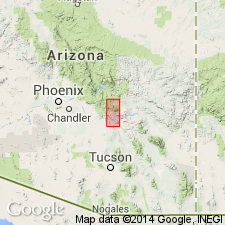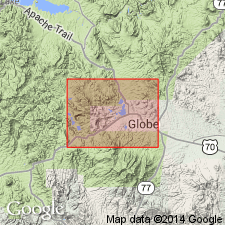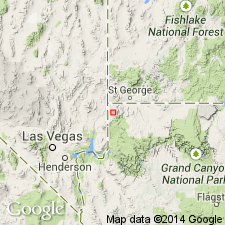
- Usage in publication:
-
- Willow Spring granite*
- Modifications:
-
- First used
- Dominant lithology:
-
- Granite
- AAPG geologic province:
-
- Southwestern Basin-and-Range region
Summary:
First used for a small isolated mass less than 1 sq mi north of Webster Gulch in northwest part of Globe quad, Gila Co, AZ in Southwestern Basin-and-Range region. Probably named for Willow Spring Gulch, T. 1 S., R. 14 E. No type locality designated. Composed of gray, fine-grained rock of granitic composition. Occasional phenocrysts of orthoclase or microcline occur scattered through a nearly aphanitic groundmass. May be closely associated with Lost Gulch monzonite. Is not known whether it is older or younger than Schultze granite (first used). Assigned a pre-Cambrian age on geologic map. It may be associated with the Lost Gulch monzonite (first used).
Source: GNU records (USGS DDS-6; Denver GNULEX).

- Usage in publication:
-
- Willow Spring granite*
- Modifications:
-
- Overview
- Age modified
- AAPG geologic province:
-
- Southwestern Basin-and-Range region
Summary:
Willow Spring granite. Generally a gray, fine-grained granite. Under a petrographic microscope, a hypidiomorphic granular aggregate of quartz and microcline with oligoclase and biotite. Secondary minerals are kaolinite, epidote, and chlorite. Accessory minerals are apatite, iron ore, and tourmaline. Exposed in area less than 1 sq mi, north of Webster Gulch in Miami district, Gila County, central Arizona. Bounded by faults. Age is Mesozoic(?), probably early Mesozoic.
Source: US geologic names lexicon (USGS Bull. 896, p. 2344); supplemental information from GNU records (USGS DDS-6; Denver GNULEX).

- Usage in publication:
-
- Willow Spring granodiorite*
- Modifications:
-
- Areal extent
- Redescribed
- Dominant lithology:
-
- Granodiorite
- AAPG geologic province:
-
- Southwestern Basin-and-Range region
Summary:
Willow Spring granodiorite. Redescribed from Globe-Miami district, Gila County, Arizona. A biotite granodiorite porphyry with orthoclase phenocrysts, 10 to 30 mm long, and a fine-grained, uniform, groundmass of quartz, feldspar, and finely disseminated biotite giving its' gray color. Accessory minerals are apatite, magnetite, and sphene. Border facies is biotite-muscovite granite. Weathers rapidly; forms basin-like areas. Intrudes Pinal schist. Intruded by Schultze granite. Considered younger than the Apache group. No fragments of Willow Spring have been found in Scanlan conglomerate. Age is Late Cretaceous and early Tertiary.
Source: Modified from GNU records (USGS DDS-6; Denver GNULEX).

- Usage in publication:
-
- Willow Spring Granodiorite*
- Modifications:
-
- Age modified
- AAPG geologic province:
-
- Southwestern Basin-and-Range region
Summary:
Is the second oldest intrusive in district, Southwestern Basin-and-Range region. Geologic map. Cross section. Occurs as three separate masses; the eastern two masses have core and border phases. Intrudes Pinal Schist and the granite of Manitou Hill. Probably is same age as Madera Diorite which is about 1,600 m.y. Cut by dikes of Lost Gulch Quartz Monzonite. Eleven K-Ar ages (6 interior, 5 border) reported; they range from 57.2 +/-0.6 to 1,870 +/-12 m.y. Probably all were reset by Schultze Granite. Age modified from Late Cretaceous or early Tertiary to Precambrian X or Y. Thought to predate 1,422 +/-14 m.y.
Source: GNU records (USGS DDS-6; Denver GNULEX).
For more information, please contact Nancy Stamm, Geologic Names Committee Secretary.
Asterisk (*) indicates published by U.S. Geological Survey authors.
"No current usage" (†) implies that a name has been abandoned or has fallen into disuse. Former usage and, if known, replacement name given in parentheses ( ).
Slash (/) indicates name conflicts with nomenclatural guidelines (CSN, 1933; ACSN, 1961, 1970; NACSN, 1983, 2005, 2021). May be explained within brackets ([ ]).

